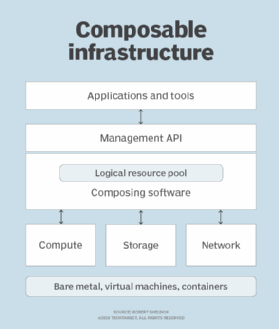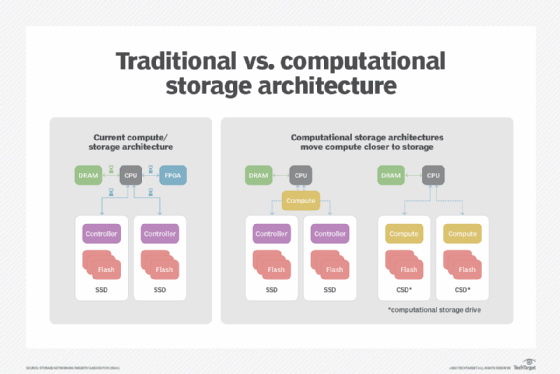
Getty Images
Can composable infrastructure and computational storage mix?
'Composable' and 'computational' are often said in the same breath, but how exactly are they related -- or not? While there are differences, a combination could serve enterprises.
On the surface, composable infrastructure and computational storage seem like opposite technologies. Going forward, however, organizations could use both.
Startups leading the way in computational storage include Fungible and ScaleFlux. Fungible, for one, has designed a storage system to be composable, with an eye on hyperscale customers. There are several reasons why an enterprise would want to take advantage of the two types of platform, such as improving latency.
What is composable infrastructure?
Server virtualization was based on the idea that physical hosts contain more resources than most workloads need. Organizations could share these hardware resources between workloads.
Composable infrastructure takes this concept of resource sharing to the next level. It groups infrastructure components together into resource pools where workloads can use them. When a workload no longer needs certain hardware resources, the resources return to the pool so another workload can use them.

Composable infrastructure environments pool together resources such as compute, memory, networking hardware and storage. These components do not need to all reside within the same system. Composable infrastructure environments can scale horizontally -- the resources in newly added nodes are simply added to the pool. Resources are disaggregated in this way, so nodes must connect together through high-speed interconnects.
What is computational storage?
Computational storage is a relatively new technology in which a CPU and memory are either placed inside of an SSD or near the storage hardware. Organizations can perform certain tasks at the storage level rather than burdening the system's CPU.
Storage encryption and video processing are good candidates for computational storage. Computational storage is not limited to these types of tasks -- some vendors can run an entire server OS at the storage level.

How to use composable infrastructure and computational storage together
Composable infrastructure and computational storage have key differences. Whereas composable infrastructure depends on a high-speed fabric between infrastructure components, computational storage does not rely on such a fabric because the memory and CPU cores are in the drive.
Composable infrastructure systems are convenient, particularly for organizations that have unpredictable workloads and need flexibility. However, they are not without issue. The nature of composable infrastructure means that there is added latency. Conversely, computational storage places memory, storage and CPU resources all in one place to avoid excessive latency.
It's likely that organizations will eventually supplement their composable infrastructure with computational storage. That way, less latency-sensitive applications can run on composable infrastructure. Organizations can reserve computational storage for workloads that are more latency-sensitive.
There are similarities between composable infrastructure and computational storage. Both are scalable. Compute resources exist in the drive, so each drive is essentially a server. As more computational drives are added to an array, the infrastructure becomes increasingly powerful.





